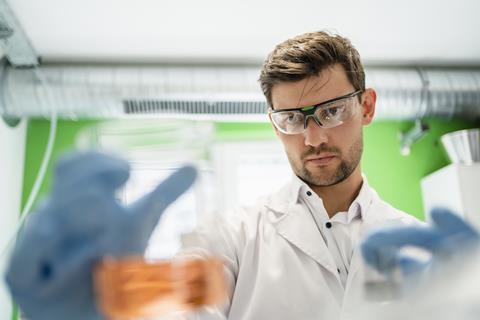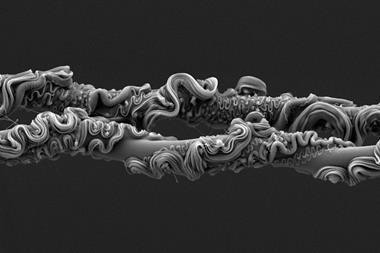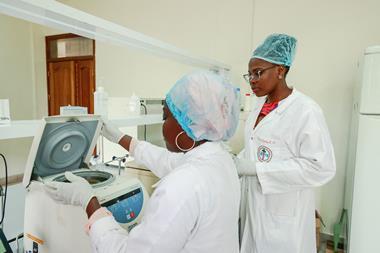Why MOFs are a great choice for the Nobel prize in chemistry

When I read about the winners of this year’s Nobel prize in chemistry, I breathed a sigh of relief. This year’s recipients are all chemists and were acknowledged for producing work that is truly chemical. Funnily enough, I’m not the only one to point this out – Derek Lowe has said exactly the same elsewhere in Chemistry World. Susumu Kitagawa, Richard Robson and Omar Yaghi jointly received the prize for developing metal-organic frameworks (MOFs), materials that are highly porous and can be used to capture and store a wide array of molecules.
What makes this discovery so refreshingly chemical? The first – perhaps obvious – requirement is for the target of discovery to be something chemical: this could be a new structure, a new chemical property, a new element or a new substance. It could also be a new technique to make (or break) something.
A characteristic example is the synthesis of urea from inorganic material in 1828 by German chemist Friedrich Wöhler. This has been lauded as an immense chemical breakthrough. In fact, it received significant attention from historians of chemistry who still debate whether (and to what extent) it contributed to the rejection of vitalism (the idea that living entities are fundamentally different in composition from non-living things).1
But this is not enough. Another thing that seems to be important when talking of genuinely chemical discoveries is the extent to which a breakthrough involves activities in a controlled environment, namely the laboratory.
Lab experiments
Indeed, this seems to be a very important feature of chemistry, more so than other experimental sciences like physics or even biology. Even if nowadays there are parts of chemistry that are not centered around laboratory work (most notably theoretical chemistry), it still holds true that one cannot really learn nor practice chemistry without spending some time in a laboratory. Experiments can of course vary in complexity: they may involve simply mixing stuff together and observing them with one’s senses, to carefully isolating materials and analysing them using very expensive and delicate machinery.
Interestingly, it is alchemy that chemistry inherited this feature from. Despite the mysterious metaphysical connotations that alchemy holds, the centrality of performing experiments and manipulating matter in a closed environment with the use of tools and apparatuses was initially developed by alchemists. Later on, with the emergence of modern science this was made explicit. For example, Denis Diderot and Jean le Rond d’Alembert defined chemistry in the Encyclopedie as ‘a science which occupies itself with the separations and union of the constituent principles of bodies, whether these are effected by nature, or the result of the operations of art, with a view to discovering the properties of bodies, or to render them suitable for a variety of uses’.2
Guillaume Francois Rouelle, an 18th century French chemist, made the role of experimental processes even more apparent: ‘Chemistry is a physical art which, by means of certain operations and instruments, teaches us to separate the various substances which enter into the composition of bodies, and to recombine these again, either to reproduce the former bodies, or to form new ones from them’.2
Practical purpose
It is within this framework that in 1993, historian William Brock said, rather beautifully, that ‘if chemistry had so much to offer through its variety of aims, then, like some religion, it was necessary to practice it rather than to expect a knowledge of it ex cathedra’.3 Experimentation and laboratory practice play prominent roles in chemistry, so much so that it has been associated with its very identity. Perhaps it should not come as a surprise that the first chemical laboratories (or workshops, as they were initially called) are found in the late 16th century.4 Nor that the first laboratories were created for chemical purposes and later on acted as a model for other laboratory sciences.5
However, there is also one more aspect to this year’s Nobel recipients that warrants calling their contribution truly chemical, namely that chemical discoveries have the potential to impact humanity in a wide variety of ways. MOFs are expected to be of value for purposes relating to gas storage, carbon capture, catalysis, electrochemistry and fluorescence-based imaging. They are expected to help with problems relating to climate change, the food industry, the energy sector and technology.
For better and for worse, innovations in chemistry have transformed all facets of our lives, bringing irreversible changes both within our personal space and within the public sphere.6 Viewed from this perspective, the development of MOFs seems be one such example of a truly chemical breakthrough. Let’s hope it will be used wisely!
References
1 PJ Ramberg, Ambix, 2000, 47, 170 (DOI: 10.1179/amb.2000.47.3.170)
2 FL Holmes and TH Levere (Eds.), Instruments and Experimentation in the History of Chemistry. MIT Press, 2000
3 WH Brock, The Fontana History of Chemistry. London: Fontana, 1993
4 PJT Morris, ChemTexts, 2021, 7, 21 (DOI: 10.1007/s40828-021-00146-x)
5 J Schummer, Why do chemists perform experiments? In: D Sobczyńska et al (eds.): Chemistry in the Philosophical Meldting Pot. Frankfurt am Main, Peter Lang, 2004, p398
6 B Bensaude-Vincent and J Simon, Chemistry: The impure science. World Scientific, 2012

















1 Reader's comment